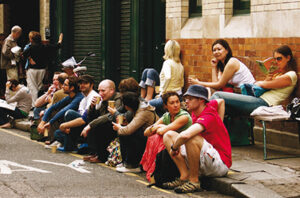Message for World Communications Day 2021
“Come and See” (Jn 1:46).
Communicating by Encountering People Where and as They Are
This is the method of all authentic human communication:
One does not communicate without moving, coming, and without being witnesses, seeing.
Communication is an encounter
Pope Francis is not an expert in communication, but he is an exceptional communicator. As such, the Pope has always imagined communication not as a complex semiotic process, but simply as an event of physical proximity. For example, it happened that Pope Francis, in 2015, allowed himself to be inspired by Mary’s visit to Elizabeth (Lk 1:39-56) to describe the miracle of communication with a more realistic and convincing interpretation than that of many media studies (cf. Message for the 54th World Communications Day).
This year, the invitation for the 55th World Communications Day is more or less similar: Communicating by Encountering People Where and as They Are. Francis, in short, asks journalists and communicators to come and see. This is the method of all authentic human communication. One does not communicate without moving, coming, and without being witnesses, seeing. It is not enough, therefore, to report news by hearsay. Three-dimensionality must be given: “we need to move, to go and see, to be with people, to listen to them and to confront reality, which will always in some way surprises us…” Because as Pope Francis writes, “…in order to know, it is necessary to encounter, to let the person in front of me speak…”
Today we often speak locked in our own computer cubicles. There no longer seems to be room for wonder, for allowing oneself to be surprised by something you encounter. Everything is already predefined. Yet the secret of Christian communication from the very beginning is precisely this: to experience something or someone you had not foreseen. The Pope thus seems to favor, without saying so, the genres of investigation and reporting. These genres prevent the diffusion of pre-packaged, self-referential information “from on high”, “that is less and less capable of grasping the truth of things and the concrete lives of people, much less the more serious social phenomena or positive movements at the grass roots level.”
In providing information, the objective is to intercept the truth of things and grasp the phenomena and growing dynamisms. The only sure way to do this, however, is through encounter.
The encounter with reality communicates

foto: PIXABAY
If the encounter decides communication, journalism is nothing other than the ‘telling of reality’. This requires desire, curiosity, passion and the ability to go where nobody else goes—particularly in those places in the world where abuses and injustices are committed against the poor or minorities. We understand why journalism in this sense can have a therapeutic function, especially for democracy and justice. This is also the way to avoid “photocopied newspapers” and information from “the palace”. To avoid this risk, which is very present today, we need to go where we think there is no need to go; where we think there is nothing good, nothing interesting to see. As the Polish journalist, writer and essayist Ryszard Kapuściński said, the problem with television and with all media in general, is that they have created a world of their own.
A world that has little to do with reality, which is why the cynic is not suited to this job. There is no possible journalism outside the relationship with other human beings. Relationship with others is the indispensable element of our work. To write about someone, it is necessary to have shared at least a little of their life. According to Francis, “The crisis of the publishing industry risks leading to a reportage created in newsrooms, in front of the computer, without ever ‘hitting the streets’.” In this sense, technological innovations are a resource because they create a network of “news that would not be available elsewhere”, and “encounters that otherwise would never happen.”
The internet “can increase the capacity for reporting and sharing, with many more eyes on the world and a constant flood of images and testimonies.” Indeed, it is precisely thanks to digital technology that we have “timely first-hand information”. In fact, everyone, even with just a mobile phone in their hand, can “become witnesses to events that otherwise would be overlooked by the traditional media, offer a contribution to society and highlight more stories, including positive ones.” The internet allows us to tell the reality and share firsthand news. On the other hand, it is clear that if there is no verification, there is risk of manipulation, which can be carried out by anyone. Francis appropriately concludes: “All of us are responsible for the communications we make, for the information we share, for the control that we can exert over fake news by exposing it.”
The journalist is what makes the difference

foto: PIXABAY
“Unless we open ourselves to this kind of encounter,” continues the Pope, “we remain mere spectators, [despite] all the technical innovations that enable us to feel immersed in a larger and more immediate reality.” However, he points out, every tool is useful only if it puts into circulation knowledge that otherwise would not circulate. In particular, he focuses on the opportunities and pitfalls of the web.
The internet and social networks can multiply the capacity and speed of news-sharing, in a continuous flow of images and testimonies – for example when it comes to communicating news to everyone emergency situations – and can therefore be “a powerful tool”. There is, he notes, the risk of “misinformation”: not only news but also images are easily manipulated, sometimes “simply for sheer narcissism.” “Being critical in this regard,” the Pope asserts, “is not about demonizing the internet, but is rather an incentive to greater discernment,” with responsibility for the content disseminated and the “control that we can exert over fake news by exposing it.” He then reiterates, “All of us are to be witnesses of the truth: to go, to see and to share.”

foto: PIXABAY
The horizon of the pandemic, which has been sweeping the world since the beginning of 2020, decisively marks this Message. The Pope warns that there is a risk of describing it, like every crisis, “only through the lens of the richer nations,” of “keeping two sets of books.” In this sense, Francis’ thoughts go to the question of vaccines and medical care, to the risk of exclusion of the poorest populations. “Who would keep us informed,” he asks “about the long wait for treatment in the poverty–stricken villages of Asia, Latin America and Africa?” This is a danger that also affects the “world of the more fortunate”, where “the social tragedy of families rapidly slipping into poverty remains largely hidden,” where “people who are no longer ashamed to wait in line before charitable organizations in order to receive a package of provisions, do not tend to make news.”
Economic differences therefore risk marking the order of distribution of the anti-Covid vaccine, with the poor always last and “the right to universal health care affirmed in principle, but stripped of real effect.”
The Pope also expressed his thanks for the courage of so many communication workers. “We owe a word of gratitude for the courage and commitment of all those professionals– journalists, camera operators, editors, directors – who often risk their lives in carrying out their work. Thanks to their efforts, we now know, for example, about the hardships endured by persecuted minorities in various parts of the world, numerous cases of oppression and injustice inflicted on the poor and on the environment, and many wars that otherwise would be overlooked. It would be a loss not only for news reporting…, were those voices to fade away. Our entire human family would be impoverished.”
The medium is the message

foto: STOCK
“The invitation to ‘come and see’ was, and continues to be, essential,” the Pope reaffirms in the Message. “We do not communicate merely with words, but with our eyes, the tone of our voice and our gestures,” says Francis, referring to the great weight that non-verbal communication has in our experience of reality. The great attraction that Jesus exercised on those who met him “depended on the truth of his preaching; yet the effectiveness of what he said was inseparable from how he looked at others, from how he acted towards them, and even from his silence… Indeed in him – the incarnate Logos – the Word took on a Face.”
The Message, which is addressed to those who deal with communication on a daily basis, does not fail to reference authors who have stressed the importance of concrete experience. “Open your eyes with wonder to what you see, let your hands touch the freshness and vitality of things, so that when others read what you write, they too can touch first-hand the vibrant miracle of life.” This was the advice that Blessed Manuel Lozano Garrido – who lived in the 1900s and was beatified in 2010 – offered to his fellow journalists. In the early centuries of Christianity, St Augustine himself recalled that “we have books in our hands, but the facts [are] before our eyes,” urging us to see in reality the fulfilment of the prophecies found in the Holy Scriptures.
“In all areas of public life, in business as well as in politics, how much empty rhetoric abounds, even in our time,” reflects the Pope. He also refers to the bold words of the great English playwright William Shakespeare, in The Merchant of Venice, on speaking infinitely, without saying anything. Frances assures us that these words, “also apply to us Christian communicators.” In this light, he points again to the proclamation of the Good News of the Gospel that continues today, “whenever we accept the compelling witness of people whose lives have been changed by their encounter with Jesus.” These are people who have accepted the same invitation, Come and see, and “were struck by the ‘surplus’ of humanity that shone through those who bore witness to Jesus.”
“That great communicator who was Paul of Tarsus,” imagines Francis, “would certainly have made use of e-mail and social messaging. Yet it was his faith, hope and charity that impressed those of his contemporaries who heard him preach.” Moreover, where he could not be encountered personally “the disciples whom he sent bore witness to his way of life in Christ.” Hence “the challenge that awaits us,” observes Francis, “is to communicate by encountering people, where they are and as they are,” as the very theme of the Message recalls. In a new way compared to his previous texts for this day, the Pope concludes with a prayer where he asks the Lord to teach us to “go where no one else will go, to take the time needed to understand, to distinguish deceptive appearances from the truth.”
And he concludes, “[Grant us] the grace to recognize your dwelling places in our world and the honesty needed to tell others what we have seen.”

